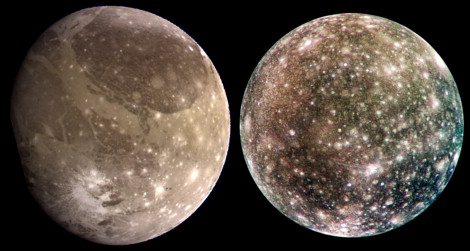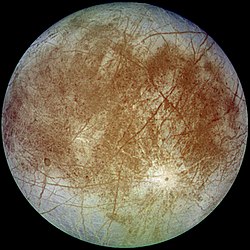"All these worlds are yours. Except Europa. Attempt no landing there." - 2010: Odyssey Two, by A.C. Clarke
Most of you think we'll first discover life outside of Earth on Europa or Enceladus. Let's have a look at these amazing worlds of ice and water! 🧵
Most of you think we'll first discover life outside of Earth on Europa or Enceladus. Let's have a look at these amazing worlds of ice and water! 🧵

In 1610, Europa, Io, Ganymede and Callisto were discovered almost at the same time by Simon Marius and Galileo Galilei.
We remember the latter better, but those names were selected by Marius. If not for him, we might have been calling them after the Medicis, Galileo's patrons...
We remember the latter better, but those names were selected by Marius. If not for him, we might have been calling them after the Medicis, Galileo's patrons...

It wasn't until the Pioneers & Voyagers in the 1970s, though, until we got a closer look at the moon and could marvel at it.
Look at this composite image captured by the Galileo probe. Does anything look strange to you? How does it differ from our Moon?
I'll give you a moment.
Look at this composite image captured by the Galileo probe. Does anything look strange to you? How does it differ from our Moon?
I'll give you a moment.

See any craters? There are a few: on the whole of Europa. It's so different from our Moon or other icy Jupiter's moons Ganymede & Callisto.
The lack of craters suggests the surface is new and the moon very geologically active. Already in late 1970s, it spurred thoughts of water.
The lack of craters suggests the surface is new and the moon very geologically active. Already in late 1970s, it spurred thoughts of water.

It's no wonder A.C. Clarke wrote '2010: Odyssey Two' in 1982, soon after the 1979 exciting Voyager images of Europa.
Also in 1979, another fantastic discovery was made on Earth: the Alvin sub found life around vents deep in the sea, independent of sunlight.
Also in 1979, another fantastic discovery was made on Earth: the Alvin sub found life around vents deep in the sea, independent of sunlight.

Active geology and potential subsurface water on Europa and deep-sea Earth life, taken together, led many to speculate about the potential life on Europa.
But its water ocean remained a speculation until the 1995 arrival of the Galileo spacecraft to Jupiter.
But its water ocean remained a speculation until the 1995 arrival of the Galileo spacecraft to Jupiter.

Remember those high school physics experiments with a magnet and a coil, showing electromagnetic induction? That's how we can reveal alien oceans!
Europa, Callisto and Ganymede have induced magnetic fields - let's have a look at what it means!
Europa, Callisto and Ganymede have induced magnetic fields - let's have a look at what it means!

Jupiter's magnetic field is inclined, so on their orbit, the moons go through varying magnetic field, akin to moving a magnet through a coil. That they have induced magnetic fields means they have some conducting layer...
...such as liquid water. 💦
...such as liquid water. 💦

From the intensity of their induced fields, we can take an educated guess at the range of possible depth and salinity of their oceans!
So yeah, Callisto and Ganymede have internal oceans too. But they're hidden much deeper than Europa's, and their surfaces suggest less activity.
So yeah, Callisto and Ganymede have internal oceans too. But they're hidden much deeper than Europa's, and their surfaces suggest less activity.

They're also much larger than Europa, meaning greater pressure at the ocean bottom - enough to turn water into a solid. What would that mean for life? 👇
clarkesworldmagazine.com/novakova_09_21/
clarkesworldmagazine.com/novakova_09_21/
(Ganymede also has its own magnetic field, by the way, as the only moon in our system. Its exploration with the upcoming @ESA_JUICE should aid our understanding of planetary magnetic fields a lot. But I digress!)
@ESA_JUICE So Europa is very geologically active & it has an ocean about 100 km deep hidden under a few to a few dozen km of ice, probably quite salty, but not too much for life as we know it. We don't know its salinity, acidity, layering & other traits, but there are lots of indirect cues.
That sounds hopeful for life, right? There might be several kinds of environments suitable for it.
On the bottom, there might be hot vents similar to those on Earth, providing heat and chemicals for life - hydrogen, methane, sulfur compounds...
On the bottom, there might be hot vents similar to those on Earth, providing heat and chemicals for life - hydrogen, methane, sulfur compounds...

The top water-ice boundary might contain interesting chemicals delivered through the active ice layer. Europa goes through Jupiter's radiation belts and is bombarded by particle radiation, creating lots of interesting chemistry on the ice surface! 

We'll have a closer look at these environments, Europa's activity & possibilities of discovering signs of life there in continuing the thread tomorrow! Apologies for pausing the thread, but my older kid is sick and the younger will need feeding soon.
In the meantime: Enceladus!
In the meantime: Enceladus!
I did a quite lengthy thread on Saturn's exciting tiny moon Enceladus when I hosted @People_Of_Space this May. That should hopefully sustain you until tomorrow :)!
https://twitter.com/People_Of_Space/status/1392008649799839746
@People_Of_Space We're back! You had two days to ponder the habitability of #Europa and #Enceladus. Still think they're our best bets of finding alien life? Where would you go first?
@People_Of_Space For a life-searching mission, I'd personally choose Enceladus simply because of the much easier availability of samples - it would be relatively easy to sample its geysers, while we don't know for sure if Europa has any (and likely not regular). No landing needed. 

@People_Of_Space Europa *may* have geysers too. In 2012, @NASAHubble detected possible water vapor (more accurately hydrogen, oxygen) near Europa's south pole. Further HST observations suggested the same, but @SOFIAtelescope did not find any. If there had been a plume, then inactive at that time. 

@People_Of_Space @NASAHubble @SOFIAtelescope There's also magnetic field and plasma data from the Galileo probe suggesting some geyser activity, but to make as sure as possible, we need to either use more sensitive Earth-based telescopes, or go back. Luckily, people are working on that...
nature.com/articles/s4155…
nature.com/articles/s4155…
@People_Of_Space @NASAHubble @SOFIAtelescope Two probes should arrive to Europa in 2029/2030: @ESA_JUICE and @EuropaClipper. The former is to investigate Europa, Callisto and (especially) Ganymede, the latter will focus on Europa. Together, they'll provide us with an amazingly full picture of the icy Galilean moons! 



@People_Of_Space @NASAHubble @SOFIAtelescope @ESA_JUICE @EuropaClipper They're not equipped for search for life, but if they observe plumes, it could really push forward a dedicated life-searching mission.
They could also observe chemicals on Europa's surface indicative of potential life...
They could also observe chemicals on Europa's surface indicative of potential life...
@People_Of_Space @NASAHubble @SOFIAtelescope @ESA_JUICE @EuropaClipper A 2018 study suggested that chemical markers of life could remain preserved in shallow ice even in the harsh radiation on Europa. This year, another tried to estimate if impacts could uncover them enough for life detection.
nature.com/articles/s4155…
www-nature-com-s.vpn.sdnu.edu.cn/articles/s4155…
nature.com/articles/s4155…
www-nature-com-s.vpn.sdnu.edu.cn/articles/s4155…
@People_Of_Space @NASAHubble @SOFIAtelescope @ESA_JUICE @EuropaClipper The short answer is: hopefully yes! JUICE and Europa Clipper will be carrying spectrometers and spectrographs to shed more light on Europa's surface composition, even potential biosignatures.
Speaking of light...
Speaking of light...

@People_Of_Space @NASAHubble @SOFIAtelescope @ESA_JUICE @EuropaClipper Jupiter is five times as far from the Sun compared to Earth, and receives approx. 25 times fewer sunlight. Still, it would be enough to support photosynthesis.
You think I'm joking, right? Photosynthesis on Europa?
Very unlikely, yes, but we shouldn't dismiss it outright.
You think I'm joking, right? Photosynthesis on Europa?
Very unlikely, yes, but we shouldn't dismiss it outright.
@People_Of_Space @NASAHubble @SOFIAtelescope @ESA_JUICE @EuropaClipper A 2002 study looked at Europa's terrain and found regions with potential cracks going through the icy crust, with water flowing periodically near the surface.
A few meters beneath it, there would be enough sunlight and radiation protection by ice...
agupubs.onlinelibrary.wiley.com/doi/full/10.10…
A few meters beneath it, there would be enough sunlight and radiation protection by ice...
agupubs.onlinelibrary.wiley.com/doi/full/10.10…

@People_Of_Space @NASAHubble @SOFIAtelescope @ESA_JUICE @EuropaClipper It all comes down to the nature of Europa's tectonics. Does water really get very near the surface or erupt in geysers of vapor, or is tectonics driven by warmer ice upwelling (making the photosynthesis option less likely)?
More for JUICE and Europa Clipper to help us reveal!
More for JUICE and Europa Clipper to help us reveal!
@People_Of_Space @NASAHubble @SOFIAtelescope @ESA_JUICE @EuropaClipper Of course, you might be asking if normally deep subsurface life, unfamiliar with sunlight, could adapt to photosynthesizing in cracks in ice near the surface. And that's a good question!
We don't know. It could originally be adapted to other wavelengths from hydrothermal vents.
We don't know. It could originally be adapted to other wavelengths from hydrothermal vents.

@People_Of_Space @NASAHubble @SOFIAtelescope @ESA_JUICE @EuropaClipper There actually is deep-sea photosynthesizing life on Earth, so it's not an impossible scenario...
pnas.org/content/102/26…
pnas.org/content/102/26…
@People_Of_Space @NASAHubble @SOFIAtelescope @ESA_JUICE @EuropaClipper However, near-surface life in water-filled cracks still seems much less likely than life clinging to the ice-ocean boundary or inhabiting hydrothermal vents on the bottom.
What's Europa's ocean like, anyway? Could any Earth life possibly survive there?
What's Europa's ocean like, anyway? Could any Earth life possibly survive there?

@People_Of_Space @NASAHubble @SOFIAtelescope @ESA_JUICE @EuropaClipper Enceladan ocean, which could be sampled by Cassini thanks to the geysers, seems similar to Earth's in its salt content and pH. For Europa, we only have indirect cues.
Based on Europa's induced magnetic field, the ocean could be slightly less salty as well as extremely salty.
Based on Europa's induced magnetic field, the ocean could be slightly less salty as well as extremely salty.
@People_Of_Space @NASAHubble @SOFIAtelescope @ESA_JUICE @EuropaClipper It was first thought to contain mainly sulfate salts, but they might not dominate it - the good old table salt NaCl was detected on Europa's surface by @NASAHubble and is likely the 'main ingredient'. The environment might not be so different from ours!
science.org/doi/10.1126/sc…
science.org/doi/10.1126/sc…
@People_Of_Space @NASAHubble @SOFIAtelescope @ESA_JUICE @EuropaClipper Surely, you might say, it contains no molecular oxygen!
Actually, it might - but not from photosynthesis (no cracks could suffice for that much!), which oxygenated Earth's oceans, but from Europa's radiation-driven chemistry.
Actually, it might - but not from photosynthesis (no cracks could suffice for that much!), which oxygenated Earth's oceans, but from Europa's radiation-driven chemistry.

@People_Of_Space @NASAHubble @SOFIAtelescope @ESA_JUICE @EuropaClipper Radiation breaks down water molecules, and the released oxygen could make it into the ocean if the ice layer is geologically active enough. The oxygen levels might even be sufficient for the development of multicellular life.
Someone in the thread mentioned Europa Report...
Someone in the thread mentioned Europa Report...

@People_Of_Space @NASAHubble @SOFIAtelescope @ESA_JUICE @EuropaClipper I love this science fiction movie, and it's a great example of SF showing mostly quite realistic science!
I could continue on and on, but you probably get the gist that Europa is an exciting place to explore. Looking forward to @ESA_JUICE and @EuropaClipper!
I could continue on and on, but you probably get the gist that Europa is an exciting place to explore. Looking forward to @ESA_JUICE and @EuropaClipper!
@People_Of_Space @NASAHubble @SOFIAtelescope @ESA_JUICE @EuropaClipper Now I'll just add a few bits here and there for those interested in diving deeper (pun intended).
These two older papers try to estimate the energy for life and possible biomass on Europa:
nature.com/articles/35000…
pnas.org/content/98/3/8…
These two older papers try to estimate the energy for life and possible biomass on Europa:
nature.com/articles/35000…
pnas.org/content/98/3/8…
@People_Of_Space @NASAHubble @SOFIAtelescope @ESA_JUICE @EuropaClipper This paper discusses the exciting possibility that structures within the icy layer might actually aid origin of life: liebertpub.com/doi/abs/10.108…
@People_Of_Space @NASAHubble @SOFIAtelescope @ESA_JUICE @EuropaClipper Europa is big enough to have inner heat sources + it's heated tidally, but even smaller, not tidally heated objects could retain liquid water with a thick enough icy shell and 'antifreeze' salts or ammonia. Just imagine these alien oceans so far away...
sciencedirect.com/science/articl…
sciencedirect.com/science/articl…
@People_Of_Space @NASAHubble @SOFIAtelescope @ESA_JUICE @EuropaClipper Liquid water might not be rare throughout the universe, but the majority of habitable oceans might not lie in the sun-basked 'habitable zone' but further out locked under kilometers of ice. If we let our imagination soar, we might think of civilizations never seeing each other...
• • •
Missing some Tweet in this thread? You can try to
force a refresh









